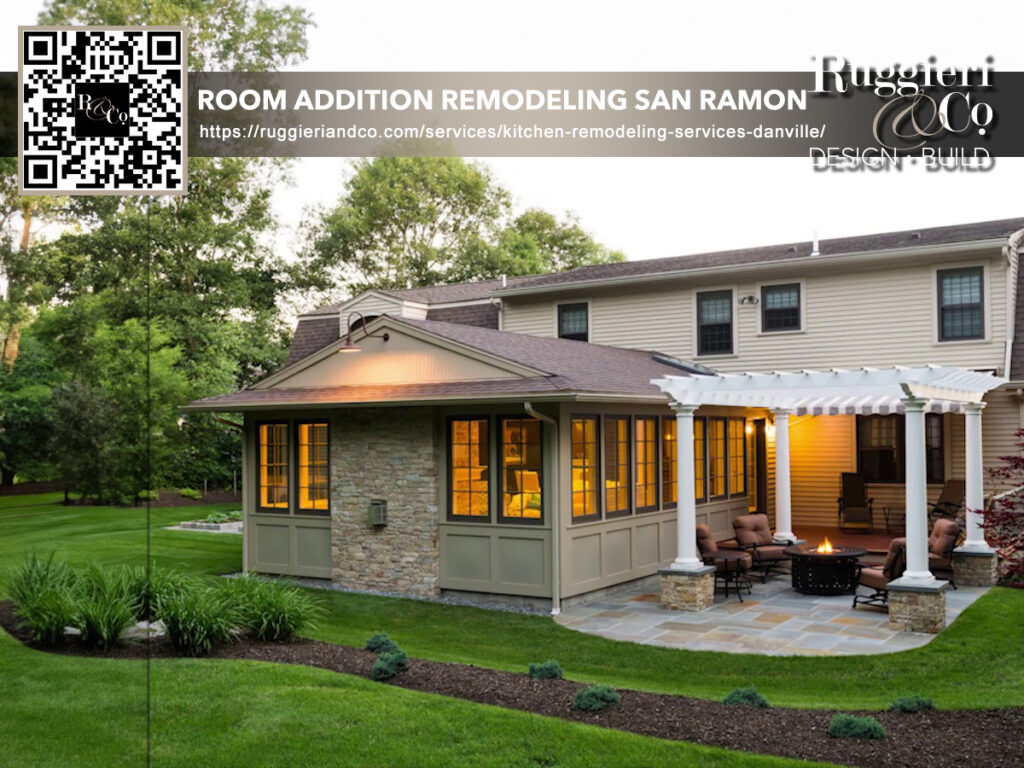As a homeowner in San Ramon CA, I always strive to make choices that have a positive impact on the environment. When it came time to add a new room to my house, I knew that I wanted to prioritize eco-friendly and energy-efficient practices. This decision turned out to be not just a responsible choice, but also a deeply fulfilling experience.
I started by researching sustainable building practices and materials, determined to create a space that would not only be beautiful and functional but also leave a minimal carbon footprint. By opting for eco-friendly building materials, maximizing natural light and ventilation, and incorporating energy-efficient technologies, I was able to design a room addition that truly aligned with my values.
Throughout the process, I was amazed at the difference even small choices could make. From selecting low VOC paints that improved indoor air quality to installing energy-efficient HVAC systems that reduced energy consumption, every decision contributed to a more sustainable living space.
Seeing the final result was incredibly rewarding. Not only did I have a stunning new room that met all my needs, but I also had the satisfaction of knowing that my home was now part of the solution to environmental challenges. It was a reminder that every choice we make, no matter how small, can have a meaningful impact.
Key Takeaways:
- Choosing eco-friendly building materials can significantly reduce the environmental impact of your room addition.
- Maximizing natural light and ventilation not only enhances the aesthetics but also reduces the need for artificial lighting and excessive HVAC usage.
- Incorporating energy-efficient technologies, such as programmable thermostats and high-efficiency HVAC systems, can significantly reduce energy consumption.
- Sustainable lighting solutions, such as LED lighting and smart controls, are both energy-efficient and cost-effective.
- Consider integrating renewable energy sources, like solar panels and geothermal heating systems, to further reduce your carbon footprint.

The Importance of Sustainable Room Additions
When embarking on a room addition project, it is essential to prioritize sustainability. By incorporating eco-friendly and energy-efficient practices, you not only contribute to a healthier environment but also enjoy numerous benefits for your home and your wallet.
Sustainable room additions go beyond simply expanding your living space; they provide an opportunity to reduce your carbon footprint and create a more comfortable, efficient, and environmentally friendly home. Let’s explore some of the key reasons why sustainability should be at the forefront of your room addition plans.
1. Environmental Impact
Creating a sustainable room addition means adopting practices and materials that minimize the negative impact on the environment. By choosing energy-efficient systems, eco-friendly materials, and incorporating renewable energy sources, you can significantly reduce your home’s carbon emissions and contribute to a healthier planet for future generations.
2. Energy Efficiency
Sustainable room additions are designed to maximize energy efficiency. By implementing proper insulation, utilizing natural lighting and ventilation strategies, and installing energy-saving fixtures, you can significantly reduce your energy consumption and lower utility bills. This not only saves you money but also lessens the demand for non-renewable energy sources.
3. Improved Indoor Air Quality
Choosing sustainable materials, such as low VOC paints and toxin-free building materials, can greatly enhance the indoor air quality of your new room addition. By minimizing the presence of harmful chemicals and promoting proper ventilation, you create a healthier living environment for you and your family.
4. Increased Property Value
Sustainable features and energy-efficient upgrades are highly desirable in today’s real estate market. By incorporating sustainable practices into your room addition, you not only enhance your home’s value but also attract eco-conscious buyers who are willing to pay a premium for homes with green features.
5. Long-Term Savings
While sustainable room additions may require a higher upfront investment, they offer long-term savings through reduced energy consumption and lower maintenance costs. With energy-efficient appliances, insulation, and renewable energy sources, you can significantly decrease your monthly utility bills and enjoy substantial savings over the lifespan of your home.
By prioritizing sustainability, you not only make a positive impact on the environment but also create a more efficient, comfortable, and valuable home. In the following sections, we will explore practical strategies for implementing sustainability in your room addition project, ranging from choosing eco-friendly building materials to incorporating renewable energy sources.
Choosing Eco-Friendly Building Materials
When embarking on a room addition project, selecting eco-friendly building materials is a vital step towards creating a sustainable and environmentally conscious space. By choosing materials that are both eco-friendly and durable, you can reduce the impact on the environment while ensuring long-term durability for your addition.
One of the options to consider is using recycled materials. Recycled building materials, such as reclaimed wood or recycled metal, not only minimize waste but also add a unique character to your room addition. Additionally, these materials often boast the same quality and strength as their non-recycled counterparts.
Low VOC (volatile organic compounds) paints are another eco-friendly choice for your room addition. These paints contain significantly fewer harmful chemicals compared to traditional paints, reducing indoor air pollution and minimizing health risks. Opting for low VOC paints not only benefits the environment but also improves the air quality in your home, providing a healthier living space for you and your family.
Energy efficiency is also an essential aspect to consider. Choose insulation materials that have high thermal resistance, such as cellulose insulation or spray foam insulation. These options reduce heat transfer, keeping your room addition well-insulated throughout the year and lowering energy consumption for heating and cooling.
To help you make an informed decision, here is a table showcasing various eco-friendly building materials and their benefits:
| Building Material | Benefits |
|---|---|
| Reclaimed Wood | – Reduces deforestation – Unique aesthetic appeal – Durable and long-lasting |
| Recycled Metal | – Decreases reliance on primary metal sources – High structural integrity – Recyclable |
| Low VOC Paints | – Minimizes indoor air pollution – Improves air quality – Fewer harmful health effects |
| Cellulose Insulation | – High thermal resistance – Made from recycled paper – Reduces energy consumption |
| Spray Foam Insulation | – Excellent thermal insulation – Creates an airtight seal – Reduces energy costs |
By incorporating these eco-friendly building materials into your room addition, you can create a space that minimizes environmental impact, promotes sustainability, and enhances your overall living experience.
Maximizing Natural Light and Ventilation
When designing your room addition, it is essential to prioritize the integration of natural light and ventilation. Not only do these elements enhance the overall aesthetics of your space but they also offer numerous benefits for your well-being and energy efficiency.
Ambient natural light can significantly improve the atmosphere and mood in a room, making it feel more spacious, inviting, and comfortable. By maximizing the use of natural light, you can reduce the dependence on artificial lighting during the day and potentially lower your energy consumption.
Furthermore, proper ventilation is key to maintaining a healthy indoor environment. Good airflow can help eliminate allergens, pollutants, and excessive moisture, creating a more comfortable living space. By maximizing natural ventilation, you can minimize the need for excessive HVAC usage and potentially lower your energy bills. Get a more comprehensive view of How to Incorporate a Water Feature into Your Outdoor Living Space.
Design strategies for maximizing natural light and ventilation:
- Install larger windows or skylights to allow ample natural light to enter the room.
- Position windows strategically to optimize sunlight exposure throughout the day.
- Utilize lighter window treatments or sheer curtains to allow maximum sunlight penetration.
- Consider the orientation of your room addition to take advantage of the sun’s path.
- Incorporate glazed doors or glass partitions to allow light to flow between rooms.
- Implement ventilation systems such as ceiling fans or operable windows to enhance airflow.
By implementing these design strategies, you can create a room addition that not only benefits from natural light and ventilation but also helps reduce your environmental impact and energy consumption.
Key Takeaways:
Maximizing natural light and ventilation in your room addition offers several advantages. It enhances the aesthetics, creates a more comfortable living space, reduces the reliance on artificial lighting, and promotes energy efficiency. By incorporating design strategies that prioritize natural light and ventilation, you can improve the overall quality of your room addition while reducing your environmental footprint.
Energy-Efficient HVAC Systems
When it comes to room additions, ensuring energy efficiency is key. The right HVAC system can make a significant difference in both energy consumption and comfort. By investing in energy-efficient HVAC systems, you can not only reduce your environmental impact but also save on your energy bills in the long run.
One option to consider is programmable thermostats. These smart devices allow you to set temperature schedules and adjust settings based on occupancy, ensuring that you only heat or cool the space when needed. By optimizing temperature control, programmable thermostats help minimize energy waste.
Another crucial aspect is choosing high-efficiency air conditioning units. Look for models with a higher Seasonal Energy Efficiency Ratio (SEER) rating, as they are designed to consume less energy while providing the same level of cooling. Investing in energy-efficient air conditioning ensures optimal cooling performance with reduced energy consumption.
Proper Insulation
Insulation plays a vital role in maintaining indoor comfort and energy efficiency. During a room addition project, it’s essential to ensure proper insulation in the walls, floors, and ceilings. Adequate insulation helps prevent heat transfer, keeping the space cool in summer and warm in winter without excessive reliance on HVAC systems.
Consider using energy-efficient insulation materials such as spray foam insulation or cellulose insulation. These options provide better thermal resistance compared to traditional fiberglass insulation, reducing energy waste and promoting a more comfortable indoor environment.

Installing energy-efficient HVAC systems and proper insulation in your room addition not only helps reduce the environmental footprint but also contributes to long-term energy savings. By optimizing temperature control and minimizing energy waste, you can enjoy a comfortable living space while lowering your utility bills.
Sustainable Lighting Solutions
When it comes to creating a sustainable and energy-efficient room addition, lighting plays a crucial role. By incorporating sustainable lighting solutions, you can not only reduce your energy consumption but also enhance the overall ambiance of your space. In this section, we will explore the benefits of using LED lighting, smart lighting controls, and energy-saving fixtures and bulbs.
Benefits of LED Lighting
LED lighting is a popular choice for eco-conscious homeowners due to its numerous benefits. Compared to traditional incandescent bulbs, LEDs consume significantly less energy, resulting in lower electricity bills and reduced environmental impact. Additionally, LEDs have a longer lifespan, saving you money on replacements and reducing waste. They also emit less heat, making them safer and more efficient. By using LED lighting in your room addition, you can contribute to a more sustainable and cost-effective lighting solution.
Smart Lighting Controls for Efficiency
Smart lighting controls offer another avenue for promoting sustainability in your room addition. With the ability to adjust light intensity, set schedules, and automate lighting based on occupancy or natural light levels, smart lighting controls help optimize energy usage. By maximizing natural light and only using artificial lighting when needed, you can further reduce your carbon footprint and enhance energy efficiency. Whether it’s motion sensors, dimmers, or timers, incorporating smart lighting controls can significantly enhance sustainability in your space.
Importance of Energy-Saving Fixtures and Bulbs
Choosing energy-saving fixtures and bulbs is crucial for achieving sustainable lighting in your room addition. Look for fixtures and bulbs that are ENERGY STAR certified, as they meet strict energy efficiency and performance criteria established by the U.S. Environmental Protection Agency. These products consume less energy but still provide high-quality lighting. It’s also recommended to opt for bulbs with lower wattage or lumens, as they require less energy to produce the same level of brightness. By carefully selecting energy-saving fixtures and bulbs, you can create an environmentally friendly lighting scheme without compromising on aesthetics or functionality.
| Sustainable Lighting Solutions | Benefits |
|---|---|
| LED Lighting | Energy efficiency Longer lifespan Lower heat emission |
| Smart Lighting Controls | Optimized energy usage Maximization of natural light Automation for convenience |
| Energy-Saving Fixtures and Bulbs | ENERGY STAR certified Reduced energy consumption High-quality lighting |
Incorporating Renewable Energy Sources
When it comes to making your room addition truly sustainable, incorporating renewable energy sources is a crucial step. Renewable energy sources provide a clean and environmentally friendly way to power your home, reducing your carbon footprint and dependence on non-renewable resources. Two popular options for integrating renewable energy into your room addition are solar panels and geothermal heating systems.
The Benefits of Solar Panels
Solar panels are a well-established and increasingly affordable option for generating clean electricity. By converting sunlight into electricity, solar panels can power your room addition and offset your energy consumption from the grid. Some key benefits of installing solar panels include:
- Reduced energy bills: Solar panels harness the free and abundant energy of the sun, significantly reducing your reliance on traditional electricity sources and lowering your energy bills.
- Environmental sustainability: Solar energy is clean and renewable, emitting zero greenhouse gases during operation. By using solar panels, you contribute to the reduction of carbon emissions and help combat climate change.
- Energy independence: With solar panels installed, you can generate your own electricity, reducing your dependence on the electrical grid and protecting yourself from rising energy costs.

The Advantages of Geothermal Heating Systems
Geothermal heating systems utilize the energy stored in the Earth to heat and cool your home efficiently. These systems tap into stable underground temperatures to provide a steady source of heating and cooling throughout the year. Here are some benefits of integrating geothermal energy into your room addition:
- Energy efficiency: Geothermal heating systems are highly efficient, offering substantial energy savings compared to traditional heating and cooling methods. By transferring heat from the Earth, these systems provide consistent and comfortable temperatures while using less energy.
- Long-term cost savings: While the initial installation cost of geothermal systems may be higher than conventional systems, the long-term savings on energy bills make them a cost-effective choice. Over time, the energy savings can offset the upfront investment.
- Environmental friendliness: Geothermal systems produce fewer carbon emissions compared to fossil fuel-based heating systems. By utilizing the Earth’s natural heat, geothermal energy helps reduce greenhouse gas emissions and protect the environment.
| Solar Panels | Geothermal Heating Systems |
|---|---|
| Harnesses sunlight to generate electricity | Utilizes the Earth’s natural heat for heating and cooling |
| Reduces energy bills and provides energy independence | Offers high energy efficiency and long-term cost savings |
| Contributes to environmental sustainability | Produces fewer carbon emissions |
By incorporating renewable energy sources like solar panels and geothermal heating systems into your room addition, you can not only lower your energy bills but also make a positive impact on the environment. Take advantage of these sustainable options to create a greener and more energy-efficient living space.
Planning for Waste Reduction and Recycling
When undertaking a room addition project, it is essential to integrate waste reduction and recycling practices into your planning. Not only does this contribute to environmental sustainability, but it also helps minimize the impact on landfills and conserve valuable resources. Here are some tips and strategies to ensure responsible waste management and recycling during your room addition:
1. Preparation: Before starting the project, consider conducting a waste audit to identify the types and quantities of materials that will be discarded. This will enable you to plan for appropriate recycling methods and disposal options.
2. Materials Management: Opt for eco-friendly building materials that are recyclable or made from recycled content. Reclaimed wood, recycled metal, and eco-conscious insulation options are excellent choices for reducing waste. Additionally, buy materials in accurate quantities to minimize leftover waste.
3. Recycling Program: Set up a recycling program on-site to separate and collect recyclable materials such as cardboard, plastic, metal, and glass. Ensure clear signage and designated recycling bins are available for easy sorting by construction workers and subcontractors.
4. Donation and Reuse: Consider donating usable items such as cabinets, fixtures, and appliances to local charities or Habitat for Humanity. Not only does this divert waste from landfills, but it also benefits those in need. Reusing items that are in good condition reduces the demand for new materials.
Incorporating waste reduction and recycling practices into your room addition project can have a significant positive impact on the environment. By following these tips, you can contribute to a more sustainable future while creating your dream space.
Ruggieri & Co Home Remodeling Danville is a premier home remodeling contractor in Blackhawk, Danville, CA, and the surrounding areas. We specialize in creating dream homes with the highest standards and a personal touch. With over 20 years of experience, we guarantee superior craftsmanship and attention to detail. We offer free quotes for our services and strive to provide our customers with the best service and value. From interior and exterior renovations to custom work, we are your go-to source for all home remodeling needs. Visit us today at 290 Rose St # A, Danville, CA 94526, and let us help you make your dream home a reality.








